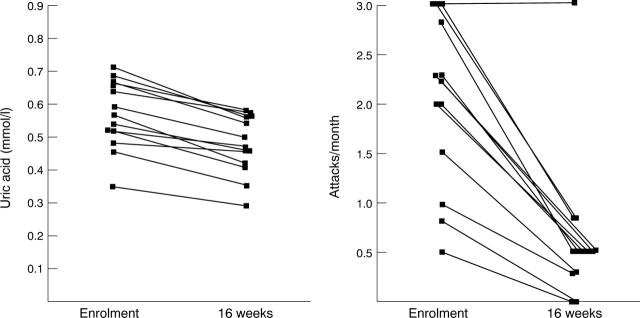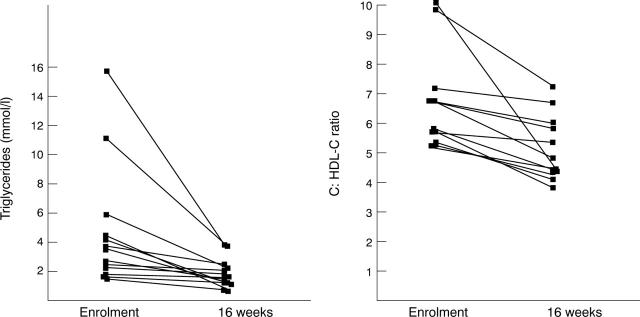Abstract
OBJECTIVES—Insulin resistance (IR) has been increasingly implicated in the pathogenesis of gout. The lipoprotein abnormalities described in hyperuricaemic subjects are similar to those associated with IR, and insulin influences renal urate excretion. In this study it was investigated whether dietary measures, reported to be beneficial in IR, have serum uric acid (SU) and lipid lowering effects in gout. METHODS—Thirteen non-diabetic men (median age 50, range 38-62) were enrolled. Each patient had had at least two gouty attacks during the four months before enrolment. Dietary recommendations consisted of calorie restriction to 6690 kJ (1600 kcal) a day with 40% derived from carbohydrate, 30% from protein, and 30% from fat; replacement of refined carbohydrates with complex ones and saturated fats with mono- and polyunsaturated ones. At onset and after 16 weeks, fasting blood samples were taken for determination of SU, serum cholesterol (C), low density lipoprotein cholesterol (LDL-C), high density lipoprotein cholesterol (HDL-C), and triglycerides (TGs). Results were expressed as median (SD). RESULTS—At onset, the body mass index (BMI) was 30.5 (8.1) kg/m2. Dietary measures resulted in weight loss of 7.7 (5.4) kg (p=0.002) and a decrease in the frequency of monthly attacks from 2.1 (0.8) to 0.6 (0.7) (p=0.002). The SU decreased from 0.57 (0.10) to 0.47 (0.09) mmol/l (p=0.001) and normalised in 7 (58%) of the 12 patients with an initially raised level. Serum cholesterol decreased from 6.0 (1.7) to 4.7 (0.9) mmol/l (p=0.002), LDL-C from 3.5 (1.2) to 2.7 (0.8) mmol/l (p=0.004), TGs from 4.7 (4.2) to 1.9 (1.0) mmol/l (p=0.001), and C:HDL-C ratios from 6.7 (1.7) to 5.2 (1.0) (p=0.002). HDL-C levels increased insignificantly. High baseline SU, frequency of attacks, total cholesterol, LDL-C and TG levels, and total C:HDL-C ratios correlated with higher decreases in the respective variables upon dietary intervention (p<0.05). CONCLUSION—The results suggest that weight reduction associated with a change in proportional macronutrient intake, as recently recommended in IR, is beneficial, reducing the SU levels and dyslipidaemia in gout. Current dietary recommendations for gout may need re-evaluation.
Full Text
The Full Text of this article is available as a PDF (118.6 KB).
Figure 1 .
Serum uric acid concentrations and monthly gouty attack frequency at enrolment and 16 weeks.
Figure 2 .
Serum triglyceride concentrations and C:HDL-C ratios at enrolment and after 16 weeks.
Selected References
These references are in PubMed. This may not be the complete list of references from this article.
- Assmann G., Schulte H., Funke H., von Eckardstein A. The emergence of triglycerides as a significant independent risk factor in coronary artery disease. Eur Heart J. 1998 Oct;19 (Suppl 1000):M8–14. [PubMed] [Google Scholar]
- Castelli W. P., Garrison R. J., Wilson P. W., Abbott R. D., Kalousdian S., Kannel W. B. Incidence of coronary heart disease and lipoprotein cholesterol levels. The Framingham Study. JAMA. 1986 Nov 28;256(20):2835–2838. [PubMed] [Google Scholar]
- Cigolini M., Targher G., Tonoli M., Manara F., Muggeo M., De Sandre G. Hyperuricaemia: relationships to body fat distribution and other components of the insulin resistance syndrome in 38-year-old healthy men and women. Int J Obes Relat Metab Disord. 1995 Feb;19(2):92–96. [PubMed] [Google Scholar]
- Davidson M. B. Clinical implications of insulin resistance syndromes. Am J Med. 1995 Oct;99(4):420–426. doi: 10.1016/s0002-9343(99)80191-0. [DOI] [PubMed] [Google Scholar]
- Emmerson B. T. The management of gout. N Engl J Med. 1996 Feb 15;334(7):445–451. doi: 10.1056/NEJM199602153340707. [DOI] [PubMed] [Google Scholar]
- Emmerson B. Hyperlipidaemia in hyperuricaemia and gout. Ann Rheum Dis. 1998 Sep;57(9):509–510. doi: 10.1136/ard.57.9.509. [DOI] [PMC free article] [PubMed] [Google Scholar]
- Facchini F., Chen Y. D., Hollenbeck C. B., Reaven G. M. Relationship between resistance to insulin-mediated glucose uptake, urinary uric acid clearance, and plasma uric acid concentration. JAMA. 1991 Dec 4;266(21):3008–3011. [PubMed] [Google Scholar]
- Frick M. H., Elo O., Haapa K., Heinonen O. P., Heinsalmi P., Helo P., Huttunen J. K., Kaitaniemi P., Koskinen P., Manninen V. Helsinki Heart Study: primary-prevention trial with gemfibrozil in middle-aged men with dyslipidemia. Safety of treatment, changes in risk factors, and incidence of coronary heart disease. N Engl J Med. 1987 Nov 12;317(20):1237–1245. doi: 10.1056/NEJM198711123172001. [DOI] [PubMed] [Google Scholar]
- Gardner C. D., Kraemer H. C. Monounsaturated versus polyunsaturated dietary fat and serum lipids. A meta-analysis. Arterioscler Thromb Vasc Biol. 1995 Nov;15(11):1917–1927. doi: 10.1161/01.atv.15.11.1917. [DOI] [PubMed] [Google Scholar]
- Jeppesen J., Facchini F. S., Reaven G. M. Individuals with high total cholesterol/HDL cholesterol ratios are insulin resistant. J Intern Med. 1998 Apr;243(4):293–298. doi: 10.1046/j.1365-2796.1998.00301.x. [DOI] [PubMed] [Google Scholar]
- Knopp R. H. Drug treatment of lipid disorders. N Engl J Med. 1999 Aug 12;341(7):498–511. doi: 10.1056/NEJM199908123410707. [DOI] [PubMed] [Google Scholar]
- Matthews D. R., Hosker J. P., Rudenski A. S., Naylor B. A., Treacher D. F., Turner R. C. Homeostasis model assessment: insulin resistance and beta-cell function from fasting plasma glucose and insulin concentrations in man. Diabetologia. 1985 Jul;28(7):412–419. doi: 10.1007/BF00280883. [DOI] [PubMed] [Google Scholar]
- Nicholls A., Scott J. T. Effect of weight-loss on plasma and urinary levels of uric acid. Lancet. 1972 Dec 9;2(7789):1223–1224. doi: 10.1016/s0140-6736(72)92271-4. [DOI] [PubMed] [Google Scholar]
- Parillo M., Rivellese A. A., Ciardullo A. V., Capaldo B., Giacco A., Genovese S., Riccardi G. A high-monounsaturated-fat/low-carbohydrate diet improves peripheral insulin sensitivity in non-insulin-dependent diabetic patients. Metabolism. 1992 Dec;41(12):1373–1378. doi: 10.1016/0026-0495(92)90111-m. [DOI] [PubMed] [Google Scholar]
- Pascual E. Management of crystal arthritis. Rheumatology (Oxford) 1999 Oct;38(10):912–916. doi: 10.1093/rheumatology/38.10.912. [DOI] [PubMed] [Google Scholar]
- Piatti P. M., Monti F., Fermo I., Baruffaldi L., Nasser R., Santambrogio G., Librenti M. C., Galli-Kienle M., Pontiroli A. E., Pozza G. Hypocaloric high-protein diet improves glucose oxidation and spares lean body mass: comparison to hypocaloric high-carbohydrate diet. Metabolism. 1994 Dec;43(12):1481–1487. doi: 10.1016/0026-0495(94)90005-1. [DOI] [PubMed] [Google Scholar]
- Puig J. G., Ruilope L. M. Uric acid as a cardiovascular risk factor in arterial hypertension. J Hypertens. 1999 Jul;17(7):869–872. doi: 10.1097/00004872-199917070-00001. [DOI] [PubMed] [Google Scholar]
- Ramsay L. E., Wallis E. J., Haq I. U., Yeo W. W., Jackson P. R. Drug therapy for coronary heart disease: the Sheffield table. Lancet. 1998 Feb 7;351(9100):443–444. doi: 10.1016/s0140-6736(98)26006-5. [DOI] [PubMed] [Google Scholar]
- Reaven G. M. Do high carbohydrate diets prevent the development or attenuate the manifestations (or both) of syndrome X? A viewpoint strongly against. Curr Opin Lipidol. 1997 Feb;8(1):23–27. doi: 10.1097/00041433-199702000-00006. [DOI] [PubMed] [Google Scholar]
- Takahashi S., Yamamoto T., Moriwaki Y., Tsutsumi Z., Higashino K. Impaired lipoprotein metabolism in patients with primary gout--influence of alcohol intake and body weight. Br J Rheumatol. 1994 Aug;33(8):731–734. doi: 10.1093/rheumatology/33.8.731. [DOI] [PubMed] [Google Scholar]
- Tinahones J. F., Pérez-Lindón G., C-Soriguer F. J., Pareja A., Sánchez-Guijo P., Collantes E. Dietary alterations in plasma very low density lipoprotein levels modify renal excretion of urates in hyperuricemic-hypertriglyceridemic patients. J Clin Endocrinol Metab. 1997 Apr;82(4):1188–1191. doi: 10.1210/jcem.82.4.3866. [DOI] [PubMed] [Google Scholar]
- Vuorinen-Markkola H., Yki-Järvinen H. Hyperuricemia and insulin resistance. J Clin Endocrinol Metab. 1994 Jan;78(1):25–29. doi: 10.1210/jcem.78.1.8288709. [DOI] [PubMed] [Google Scholar]
- Walden C. E., Retzlaff B. M., Buck B. L., McCann B. S., Knopp R. H. Lipoprotein lipid response to the National Cholesterol Education Program step II diet by hypercholesterolemic and combined hyperlipidemic women and men. Arterioscler Thromb Vasc Biol. 1997 Feb;17(2):375–382. doi: 10.1161/01.atv.17.2.375. [DOI] [PubMed] [Google Scholar]
- de Lorgeril M., Renaud S., Mamelle N., Salen P., Martin J. L., Monjaud I., Guidollet J., Touboul P., Delaye J. Mediterranean alpha-linolenic acid-rich diet in secondary prevention of coronary heart disease. Lancet. 1994 Jun 11;343(8911):1454–1459. doi: 10.1016/s0140-6736(94)92580-1. [DOI] [PubMed] [Google Scholar]




